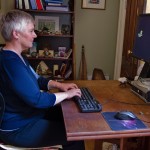Don't Do Something, Sit There
Are you sitting right now? Chances are good that you are. You might be standing and reading this on your phone or tablet, or you could be lying back on a couch or your bed. But you're probably sitting, and if you are, let me ask you something: Did you choose the way you are sitting, the arrangement of all the body parts? For most of us, the answer is no. Sitting is so common, and we have been doing it for so long, that we really pay almost no attention to it until something hurts, or until someone asks us to notice. (Did you change your position when you read the question about choice just now? Bet you did.) We tend to "set it and forget it" when we collapse into a seat, where we immediately turn to whatever activity we are doing -- desk work, eating, watching TV, waiting for and riding the bus or train.
Here's an important fact that might surprise you: sitting is an activity. It seems like the cessation of an action -- walking, for instance -- but it's just a different way of balancing the body in activity. My Alexander teacher, Alan Katz, used to say, "sitting is standing in a different position," and I am constantly helping folks discover that their sit bones at the bottom of the pelvis are like a second set of feet. These bones are shaped like little rockers on a rocking chair, and the way we allow them to support our weight can be the difference between pain and ease in our bodies.
Sitting is so basic to our lives that significant time is typically spent in Alexander lessons learning (or unlearning) how to sit. This is because we spend a great deal of time in chairs, yet paradoxically we are not designed for this sitting activity, at least not for long hours. So much has been written and said about how learning the Alexander Technique can help you sit comfortably and with less strain. Here's a recent discussion of how we relate to chairs when we think about sitting. If you have a half an hour to listen, I recommend this interview with my colleague Ariel Weiss, who describes how to apply the AT in order to sit comfortably anywhere.
Are you still sitting? Here are some things to attend to, some ways to bring awareness to what you are doing.
Stop whatever you are doing.You can resume that activity after you rebalance.
Scoot forward on your seat so that your back is not leaning against anything. Notice how the weight goes into your bottom.
Notice where your feet are. Let the soles rest on the floor just under your knees, at a 90 degree angle. Your hips shoud be level with or slightly higher than your knees. Raise or lower your seat if that's possible.
Access the integrity of your spine; allow it to rise up from the base, all the way up to support your head (it is as high as your inner ears, at about the level of your cheekbones). Please pay attention to the word "allow" here. You do not need to pull up, you only need to not pull down. If you are slouching, sense into your spinal column and let it lengthen up toward the crown of your head.
- Rock back and forth on your sitting bones. You will discover how leaning forward or falling back have a big effect on your neck, your solar plexus, and your lower back. Rock until you feel centered.
- From this new centered place, resume whatever you were doing. What are you aware of in this refreshed arrangement of parts? Can you maintain some of that awareness even as you eat/read/watch/work?
Which looks more comfortable?
A lot of learning in the Alexander process is about not doing anything "extra" when we move. Even something simple like bringing hands to the keyboard or a fork to the mouth typically includes a lot of unnecessary collapse or strain or effort. Master AT teacher Marjorie Barstow demonstrates this beautifully in a short introductory video. Skip to about minute 5:00 to see her in action, from a seated position.
One great thing about the fact that we sit so much is that we have countless opportunities to pause and notice what we are doing, and then make a new choice. This is mindful sitting, which is not just for meditation. Every time you bring awareness to how you sit, and then ease up on your body and find a more balanced way, you are repatterning your neuromuscular system, literally reshaping your brain's pathways. You will feel less exhausted as a result, because you are doing less work and becoming more dynamic.
The best way to learn this is to have some Alexander lessons. Being guided out of deadening habit and into lively wakefulness is enjoyable and practical.

